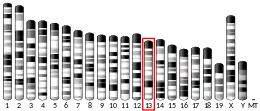| IARS1 | |||||||||||||||||||||||||||||||
|---|---|---|---|---|---|---|---|---|---|---|---|---|---|---|---|---|---|---|---|---|---|---|---|---|---|---|---|---|---|---|---|
| Identifiers | |||||||||||||||||||||||||||||||
| Aliases | IARS1, isoleucyl-tRNA synthetase 1, ILERS, isoleucyl-tRNA synthetase, PRO0785, GRIDHH, IRS, ILRS, IARS | ||||||||||||||||||||||||||||||
| External IDs | OMIM: 600709 MGI: 2145219 HomoloGene: 5325 GeneCards: IARS1 | ||||||||||||||||||||||||||||||
| |||||||||||||||||||||||||||||||
| |||||||||||||||||||||||||||||||
| |||||||||||||||||||||||||||||||
| |||||||||||||||||||||||||||||||
| Wikidata | |||||||||||||||||||||||||||||||
| |||||||||||||||||||||||||||||||
Isoleucyl-tRNA synthetase, cytoplasmic is an enzyme that in humans is encoded by the IARS1 gene.[5][6]
Aminoacyl-tRNA synthetases catalyze the aminoacylation of tRNA by their cognate amino acid. Because of their central role in linking amino acids with nucleotide triplets contained in tRNAS, aminoacyl-tRNA synthetases are thought to be among the first proteins that appeared in evolution. Isoleucine-tRNA synthetase belongs to the class-I aminoacyl-tRNA synthetase family and has been identified as a target of autoantibodies in the autoimmune disease polymyositis/dermatomyositis. Two alternatively spliced variants have been isolated that represent alternate 5' UTRs.[6]
Interactions
References
- 1 2 3 GRCh38: Ensembl release 89: ENSG00000196305 - Ensembl, May 2017
- 1 2 3 GRCm38: Ensembl release 89: ENSMUSG00000037851 - Ensembl, May 2017
- ↑ "Human PubMed Reference:". National Center for Biotechnology Information, U.S. National Library of Medicine.
- ↑ "Mouse PubMed Reference:". National Center for Biotechnology Information, U.S. National Library of Medicine.
- ↑ Nichols RC, Blinder J, Pai SI, Ge Q, Targoff IN, Plotz PH, Liu P (February 1997). "Assignment of two human autoantigen genes-isoleucyl-tRNA synthetase locates to 9q21 and lysyl-tRNA synthetase locates to 16q23-q24". Genomics. 36 (1): 210–3. doi:10.1006/geno.1996.0449. PMID 8812440.
- 1 2 "Entrez Gene: IARS1 isoleucyl-tRNA synthetase".
- ↑ Rho, S B; Lee J S; Jeong E J; Kim K S; Kim Y G; Kim S (May 1998). "A multifunctional repeated motif is present in human bifunctional tRNA synthetase". J. Biol. Chem. UNITED STATES. 273 (18): 11267–73. doi:10.1074/jbc.273.18.11267. ISSN 0021-9258. PMID 9556618.
Further reading
- Norcum MT (1991). "Structural analysis of the high molecular mass aminoacyl-tRNA synthetase complex. Effects of neutral salts and detergents". J. Biol. Chem. 266 (23): 15398–405. doi:10.1016/S0021-9258(18)98629-1. PMID 1651330.
- Nichols RC, Raben N, Boerkoel CF, Plotz PH (1995). "Human isoleucyl-tRNA synthetase: sequence of the cDNA, alternative mRNA splicing, and the characteristics of an unusually long C-terminal extension". Gene. 155 (2): 299–304. doi:10.1016/0378-1119(94)00634-5. PMID 7721108.
- Shiba K, Suzuki N, Shigesada K, et al. (1994). "Human cytoplasmic isoleucyl-tRNA synthetase: selective divergence of the anticodon-binding domain and acquisition of a new structural unit". Proc. Natl. Acad. Sci. U.S.A. 91 (16): 7435–9. Bibcode:1994PNAS...91.7435S. doi:10.1073/pnas.91.16.7435. PMC 44415. PMID 8052601.
- Rho SB, Lee KH, Kim JW, et al. (1996). "Interaction between human tRNA synthetases involves repeated sequence elements". Proc. Natl. Acad. Sci. U.S.A. 93 (19): 10128–33. Bibcode:1996PNAS...9310128R. doi:10.1073/pnas.93.19.10128. PMC 38348. PMID 8816763.
- Degoul F, Brulé H, Cepanec C, et al. (1998). "Isoleucylation properties of native human mitochondrial tRNAIle and tRNAIle transcripts. Implications for cardiomyopathy-related point mutations (4269, 4317) in the tRNAIle gene". Hum. Mol. Genet. 7 (3): 347–54. doi:10.1093/hmg/7.3.347. PMID 9466989.
- Rho SB, Lee JS, Jeong EJ, et al. (1998). "A multifunctional repeated motif is present in human bifunctional tRNA synthetase". J. Biol. Chem. 273 (18): 11267–73. doi:10.1074/jbc.273.18.11267. PMID 9556618.
- Quevillon S, Robinson JC, Berthonneau E, et al. (1999). "Macromolecular assemblage of aminoacyl-tRNA synthetases: identification of protein-protein interactions and characterization of a core protein". J. Mol. Biol. 285 (1): 183–95. doi:10.1006/jmbi.1998.2316. PMID 9878398.
- Strausberg RL, Feingold EA, Grouse LH, et al. (2003). "Generation and initial analysis of more than 15,000 full-length human and mouse cDNA sequences". Proc. Natl. Acad. Sci. U.S.A. 99 (26): 16899–903. Bibcode:2002PNAS...9916899M. doi:10.1073/pnas.242603899. PMC 139241. PMID 12477932.
- Bouwmeester T, Bauch A, Ruffner H, et al. (2004). "A physical and functional map of the human TNF-alpha/NF-kappa B signal transduction pathway". Nat. Cell Biol. 6 (2): 97–105. doi:10.1038/ncb1086. PMID 14743216. S2CID 11683986.
- Humphray SJ, Oliver K, Hunt AR, et al. (2004). "DNA sequence and analysis of human chromosome 9". Nature. 429 (6990): 369–74. Bibcode:2004Natur.429..369H. doi:10.1038/nature02465. PMC 2734081. PMID 15164053.
- Kimura K, Wakamatsu A, Suzuki Y, et al. (2006). "Diversification of transcriptional modulation: large-scale identification and characterization of putative alternative promoters of human genes". Genome Res. 16 (1): 55–65. doi:10.1101/gr.4039406. PMC 1356129. PMID 16344560.
- Ewing RM, Chu P, Elisma F, et al. (2007). "Large-scale mapping of human protein-protein interactions by mass spectrometry". Mol. Syst. Biol. 3 (1): 89. doi:10.1038/msb4100134. PMC 1847948. PMID 17353931.
This article is issued from Wikipedia. The text is licensed under Creative Commons - Attribution - Sharealike. Additional terms may apply for the media files.




